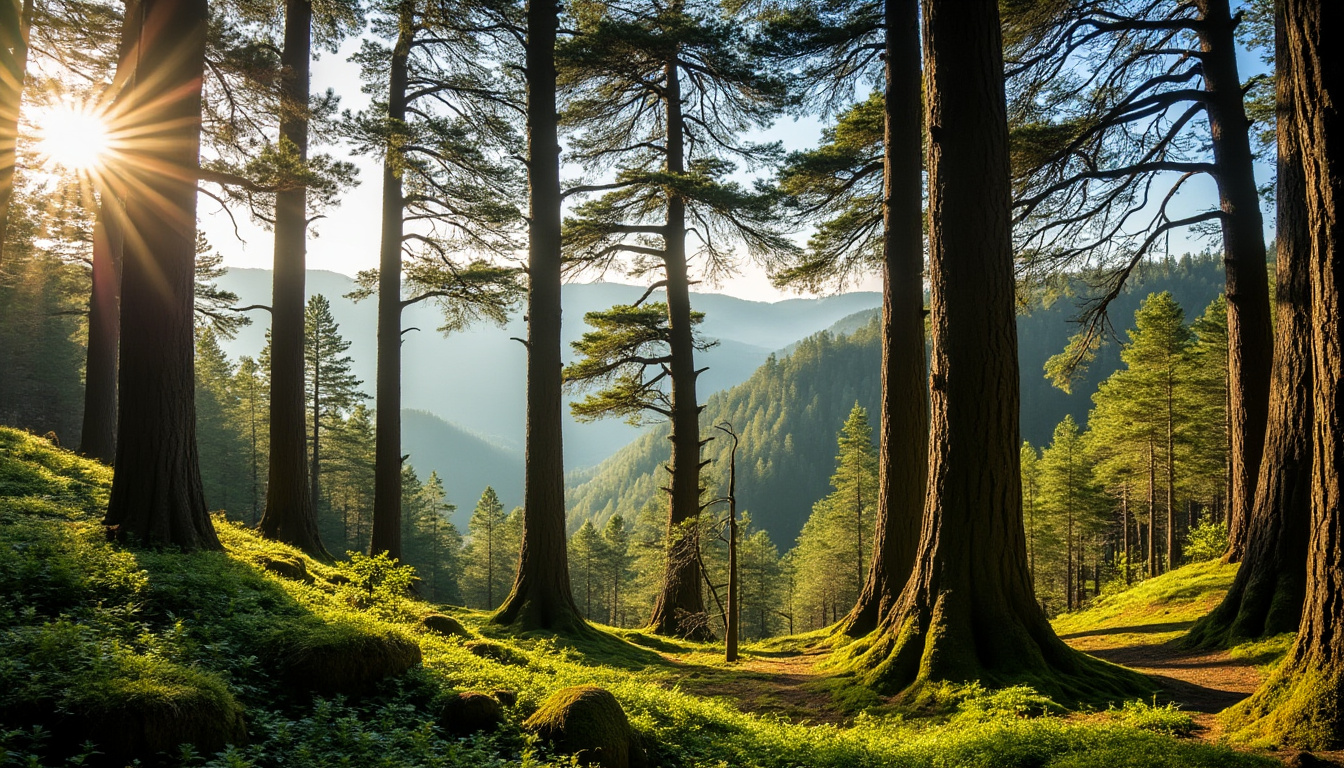Stretching across southeastern England, Surrey stands out not only for its proximity to London but also for a distinctive natural characteristic: it is England’s most wooded county. Covering over 22% of its area with dense, mature woodlands, Surrey offers a verdant sanctuary where history, ecology, and the majestic Scots pine converge. These trees, with their glowing amber bark and towering forms, have long captivated naturalists and visitors alike, embodying the heritage and ecological significance of the region. Journeying through Surrey reveals an extraordinary blend of ancient forests, vibrant ecosystems, and picturesque landscapes that underscore its reputation as an unparalleled haven for woodland enthusiasts and nature lovers.
Exploring SurreyWoodlands: England’s Leading Woodland Haven
Surrey’s extensive woodlands earn it the title of England’s greenest county, boasting an impressive 22.4% tree coverage, significantly higher than the national average. This vast expanse includes a rich diversity of species and habitats, with around a quarter of the woodlands deemed ancient, preserving ecosystems that date back centuries. These woodlands not only enhance Surrey’s natural beauty but also provide critical ecosystem services.
The preservation of these areas benefits biodiversity, creating habitats for thousands of species ranging from rare birds to mammals, insects, and diverse plant life. Moreover, woodland areas play an essential role in mitigating climate impacts—they absorb substantial amounts of carbon dioxide, help regulate water cycles by preventing soil erosion, and reduce flood risks.
Within SurreyWoodlands, the Scots pine stands as a dominant and iconic species. Known scientifically as Pinus sylvestris, the Scots pine is notable for its resilience and striking appearance. Its bark, which develops a burnished copper hue in the afternoon light, presents a captivating visage that defines much of Surrey’s scenic appeal.
- Ancient woodland areas: Support rare flora and fauna unique to these centuries-old habitats.
- Woodland carbon storage: Surrey’s woodlands contribute significantly to carbon sequestration efforts.
- Flood control: Tree roots stabilize soil and regulate water, limiting flood damage.
- Recreational green spaces: Surrey offers numerous trails and parks inviting nature walks and exploration.
| Woodland Feature | Significance | Location in Surrey |
|---|---|---|
| Ancient Woodland | Hosts endemic species, untouched for centuries | Ashtead Common, Frensham Ponds |
| Scots Pine Stands | Iconic pine species with ecological and aesthetic value | Surrey Hills, Box Hill |
| Mixed Broadleaf Woodlands | Supports a wide range of wildlife and flora diversity | Winkworth Arboretum, Hankley Common |
These expansive woodlands provide a canvas for SurreyNatureWalks and EnglishForestTrails initiatives that encourage community engagement and outdoor activities, promoting mental well-being and ecological awareness. For nature tourism, SurreyWoodlands represents a crown jewel—offering everything from peaceful strolls to challenging hikes amid scenic views.
ScotsPineHeritage: The Majestic Pines and Their Historical Significance in Surrey
The Scots pine is far more than a tree; it is a living symbol of Surrey’s ecological and cultural heritage. Tracing back about 10,500 years to their recolonization of the British Isles after the last Ice Age, these trees have shaped both the landscape and human interaction with it. Surrey’s Scots pines are distinguished by their tall, graceful, and often rugged trunks, whose bark flames a vibrant copper in the afternoon sun, a distinctive characteristic that has inspired artists and natural historians alike.
Growing up in areas like Ilkley Moor, observers have documented the unique presence of Scots pines standing as isolated clusters amid landscapes, highlighting their ability to thrive in acid soils. In Surrey, they flourish throughout the MajesticForestTours and PineCrestExperiences, areas renowned for their pristine woodland atmospheres and biodiversity.
In many ways, Surrey’s Scots pines serve as ecological anchors. Beyond their physical beauty, they provide vital habitats for varied wildlife. Their dense canopies offer protection for birds like the crested tit or redstart, while the pine cones serve as food sources for wildlife. The longevity of some specimens, capable of living up to 400-500 years, underlines their role as enduring sentinels within the ecosystem.
- Longevity: Some Scots pines in Surrey are centuries old, representing a living historical timeline.
- Ecological niches: Support birds and mammals specialized to pine woodland habitats.
- Symbolic importance: Featured in art and literature celebrating Surrey’s natural heritage.
- Adaptability: Thrive in challenging soil conditions typical of Surrey’s downlands.
| Scots Pine Trait | Ecological Role | Cultural Impact |
|---|---|---|
| Bark Coloration | Provides shelter and camouflage for insects | Recognized in local folklore and art |
| Longevity | Stabilizes woodland ecosystems over centuries | Inspires heritage celebrations and education programs |
| Needle Clusters | Provide dense foliage for nesting birds | Used in botanical studies at institutions like Kew Gardens |
Visitors embarking on CrownPineAdventures can experience these magnificent trees firsthand. Guided excursions explain their history and importance, deepening appreciation for Surrey’s natural heritage. The Scots pine, emblematic of resilience and beauty, remains a cornerstone of conservation efforts across the county.
WoodedEscape and SurreyGreenRetreats: Immersive Experiences in Surrey’s Pine-Studded Forests
For those seeking refuge from urban bustle, Surrey’s woodlands offer a range of WoodedEscape opportunities. The serene environments created by Scots pines make the county a favored destination for restorative outdoor activities. Facilities across SurreyGreenRetreats combine access to these tranquil woodlands with well-managed paths, educational centers, and picnic areas.
Surrey’s many nature reserves and parks promote MajesticForestTours and guided walks that highlight the distinct ecosystem of pine groves. Walking beneath towering Scots pines, visitors can observe how these trees contribute to healthier air quality and foster a calming atmosphere, backed by studies that show forest exposure reduces stress hormones.
- Healing benefits: Forest immersion decreases anxiety and lowers blood pressure.
- Recreational activities: Opportunities for hiking, birdwatching, and photography abound.
- Accessible trails: Designed to suit all ages and fitness levels.
- Educational facilities: Information boards and ranger talks enhance learning.
| Retreat Feature | Benefits | Representative Locations |
|---|---|---|
| Forest Bathing Trails | Stress relief, connection to nature | Holmbury Hill, Leith Hill |
| Ranger-led Walks | Educational insight into flora and fauna | Box Hill, Chobham Common |
| Picnic Areas | Family-friendly relaxation spots | Winkworth Arboretum, Hatchlands Park |
These retreats foster not only personal well-being but also encourage sustainable tourism. Visitors often contribute to woodland conservation through entrance fees and participation in volunteer activities, creating a positive feedback loop to protect Surrey’s treasured green spaces.
EnglishForestTrails and PineVista: Navigating the Scenic Routes Through Surrey’s Pine Landscapes
Surrey’s extensive network of walking trails provides exceptional access to its pine-dominated woodlands, making it possible for outdoor enthusiasts to immerse themselves in the region’s natural beauty. From gentle rambles to demanding hikes, the trails showcase the diversity and lushness of Surrey’s environment.
PineVista is a favourite among amateur and professional photographers, drawn to the interplay of light on the tall Scots pines and the vibrant greenery. The photographic appeal of these areas has increased as social media platforms highlight the stunning vistas, encouraging more visitors to explore responsibly.
- Varied trail difficulties: Suitable for families, beginners, and expert hikers.
- Strategic viewpoints: PineVista points offer panoramic views over Surrey’s rolling hills and forests.
- Wildlife spotting: Trails often intersect habitats of deer, foxes, and numerous bird species.
- Integration with local heritage: Routes pass historical landmarks and ancient woodlands.
| Trail | Length | Difficulty | Highlights |
|---|---|---|---|
| Surrey Hills Way | 64 km | Moderate | Views of woodland, rolling hills, and villages |
| Box Hill Circular | 9 km | Easy to Moderate | Scots pine groves, panoramic vistas |
| Leith Hill Hike | 14 km | Challenging | Highest point in Surrey, varied woodland |
Trails such as these serve as corridors linking Surrey’s woodlands and towns, supporting sustainable travel and eco-tourism initiatives. Whether visitors seek to rekindle a connection to the outdoors or pursue photography and wildlife observation, the pine-swathed trails present an ideal setting under Surrey’s canopy.
PineCrestExperiences and Community Engagement: Fostering a Stewardship of Surrey’s Forests
Local communities and conservation organizations play a vital role in enhancing and protecting Surrey’s wooded landscapes. Initiatives under PineCrestExperiences encourage residents and visitors alike to participate actively in conservation projects and educational outreach.
Programs may include tree planting events aimed at increasing Scots pine coverage, habitat restoration to support endangered species, and public workshops focused on woodland ecology. These efforts contribute not only to environmental sustainability but also nurture a sense of ownership and pride.
- Tree planting drives: Expanding Surrey’s woodland footprint with native pines and mixed species.
- Wildlife monitoring: Citizen science programs tracking birds and insects.
- Educational workshops: Teaching sustainable practices and forest ecology.
- Community forest festivals: Celebrating SurreyWoodlands and raising awareness.
| Activity | Purpose | Community Impact |
|---|---|---|
| Scots Pine Planting | Enhance forest density | Improved biodiversity and green spaces |
| Wildlife Surveys | Data collection for conservation | Informed management decisions |
| Ecology Workshops | Public education | Increased environmental stewardship |
In 2025, the momentum built by such collaborations underscores Surrey’s commitment to maintaining its reputation as a green retreat. Active community participation ensures that future generations can experience Surrey’s majestic Scots pines and rich woodlands, securing their place within England’s treasured natural heritage.
Frequently Asked Questions About Surrey’s Woodlands and Scots Pines
- What makes Surrey the most wooded county in England?
Surrey’s varied terrain and historical land management practices have preserved over 22% of the county as woodland, more than any other English county.
- Why are Scots pines so significant in Surrey?
They are an ancient species that has thrived in the region post-Ice Age, providing ecological stability, cultural heritage, and striking natural beauty.
- Can visitors explore Surrey’s pine forests easily?
Yes, Surrey offers well-maintained trails and guided tours such as MajesticForestTours and CrownPineAdventures, catering to all levels of outdoor enthusiasts.
- How do the woodlands contribute to environmental health?
Woodlands in Surrey absorb significant amounts of carbon, regulate water flow, prevent soil erosion, and support biodiversity.
- What community initiatives are in place to protect Surrey’s Scots pines?
Programs under PineCrestExperiences foster tree planting, wildlife monitoring, and public education to preserve and enhance woodland health.

